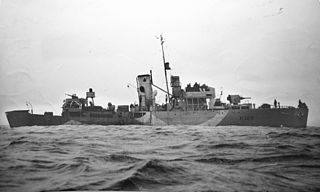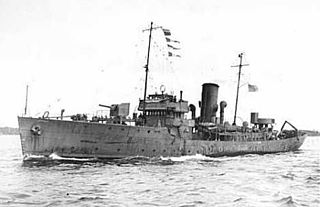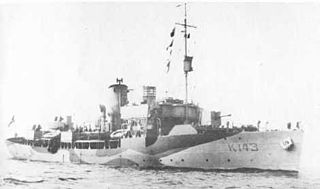
HMCS Buctouche was a Flower-class corvette that served in the Royal Canadian Navy (RCN) during the Second World War. She served primarily in the Battle of the Atlantic as a convoy escort. She was named for Bouctouche, New Brunswick.

HMCS Charlottetown was a Flower-class corvette that served the Royal Canadian Navy during the Second World War. Charlottetown's pennant number K244 is unique in that it was also used for HMCS Charlottetown, a River-class frigate.

HMCS Kenogami was a Royal Canadian Navy Flower-class corvette that served during the Second World War. The corvette served primarily in convoy escort duties during the Battle of the Atlantic. Following the war, the ship was sold for scrap and broken up.

HMCS Lévis was a Royal Canadian Navy Flower-class corvette which took part in convoy escort duties during the Second World War. She was sunk in 1941. She was named for Lévis, Quebec.

HMCS Cobalt was a Flower-class corvette of the Royal Canadian Navy which took part in convoy escort duties during the Second World War. She served primarily in the Battle of the Atlantic. She was named for Cobalt, Ontario.

HMCS Mayflower was a Flower-class corvette that served mainly in the Royal Canadian Navy during the Second World War but began her service with the Royal Navy. She saw action primarily in the Battle of the Atlantic as an ocean escort. She was named after the flowering plant Maianthemum canadense.

HMCS Trillium was a Flower-class corvette that served in the Royal Canadian Navy during the Second World War. She served mainly as a convoy escort in the Battle of the Atlantic. She was one of ten corvettes loaned to the Canadian navy by the Royal Navy and the only one which remained an ocean escort throughout the war. She was named after the flowering plant genus Trillium, which includes wakerobin, tri flower, and birthroot.

HMCS Wetaskiwin was a Flower-class corvette of the Royal Canadian Navy that served during the Second World War. She served primarily as a convoy escort in the Battle of the Atlantic. She was named after the city of Wetaskiwin, Alberta. Wetaskiwin was the first Pacific coast built corvette to enter service with the Royal Canadian Navy.

HMCS Eyebright was a Flower-class corvette that served mainly with the Royal Canadian Navy during the Second World War in the Battle of the Atlantic. She was named after the medicinal flowering plant genus Euphrasia.

HMCS Chambly was a Flower-class corvette serving in the Royal Canadian Navy. She was ordered from Canadian Vickers Ltd. in Montreal, laid down on 20 February 1940, launched on 29 July, and commissioned on 18 December 1940, named after the city of Chambly, Quebec. Chambly escorted trade convoys between Halifax Harbour and the Western Approaches through the battle of the Atlantic and, together with HMCS Moose Jaw, achieved the RCN's first U-boat kill of the war.

HMCS Prescott was a Flower-class corvette of the Royal Canadian Navy during the Second World War. She served primarily in the Battle of the Atlantic as a convoy escort. She was named for Prescott, Ontario.

HMCS Orillia was a Flower-class corvette that served with the Royal Canadian Navy during the Second World War. She fought primarily in the Battle of the Atlantic. She was named for Orillia, Ontario.

HMCS Collingwood was a Flower-class corvette that served with the Royal Canadian Navy during the Second World War. She served primarily in the Battle of the Atlantic though also saw service as a training vessel. She was named for Collingwood, Ontario.

HMCS Brandon was a Flower-class corvette that served in the Royal Canadian Navy during the Second World War. She saw service primarily in the Battle of the Atlantic as an ocean escort. She was named for Brandon, Manitoba.

HMCS Dunvegan was a Flower-class corvette that served with the Royal Canadian Navy during the Second World War. She served primarily in the Battle of the Atlantic. After the war she was sold to the Venezuelan Navy. She was named for Dunvegan, Inverness County, Nova Scotia.

HMCS Louisburg was a Flower-class corvette that served with the Royal Canadian Navy during the Second World War. She fought mainly as an ocean escort during the Battle of the Atlantic. She was sunk in 1943. She was named for Louisburg, Nova Scotia.

HMCS Morden was a Flower-class corvette that served with the Royal Canadian Navy during the Second World War. She fought primarily in the Battle of the Atlantic as an ocean escort.

HMCS Sherbrooke was a Flower-class corvette that served with the Royal Canadian Navy during the Second World War. She served primarily in the Battle of the Atlantic as an ocean escort. She is named for Sherbrooke, Quebec.

HMCS Trail was a Flower-class corvette that served with the Royal Canadian Navy during the Second World War. She served primarily in the Battle of the Atlantic as a convoy escort. She was named for Trail, British Columbia.

HMCS Giffard was a modified Flower-class corvette that served with the Royal Canadian Navy during the Second World War. She served primarily as a convoy escort in the Battle of the Atlantic. She was originally laid down by the British Royal Navy as HMS Buddleia but was never commissioned into the former, being transferred to the Royal Canadian Navy before completion. She is named for Giffard, Quebec, which at the time was a small village, but was eventually amalgamated into first, Beauport Quebec and then finally, Quebec City.
This page is based on this
Wikipedia article Text is available under the
CC BY-SA 4.0 license; additional terms may apply.
Images, videos and audio are available under their respective licenses.




















